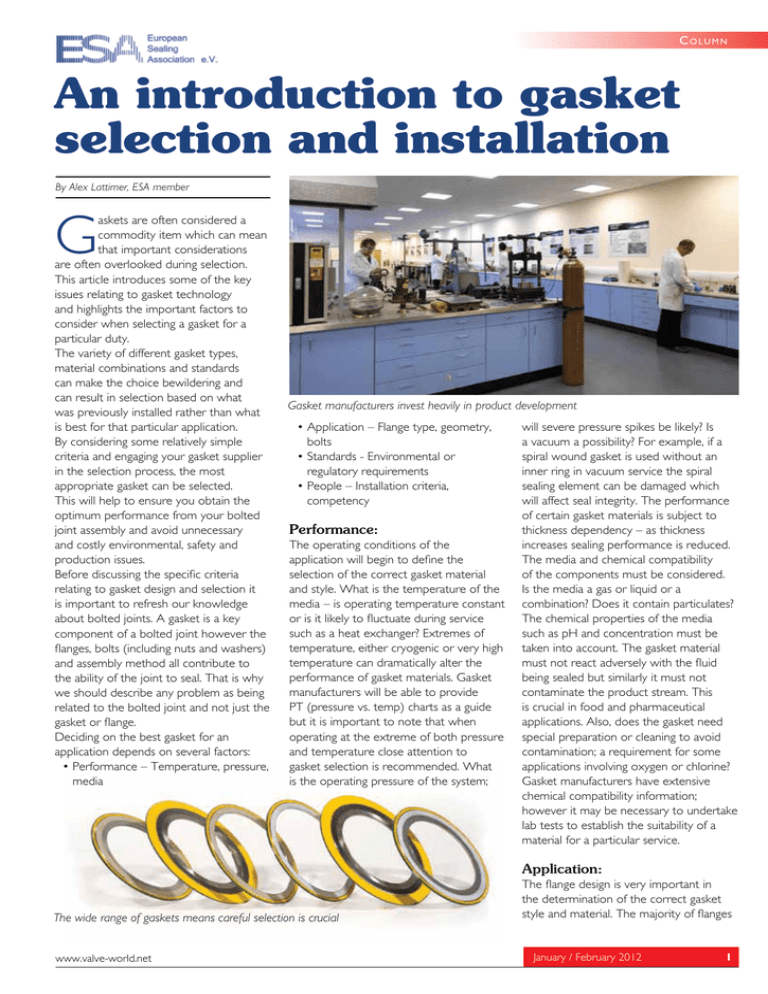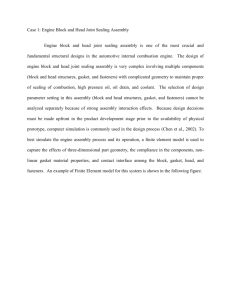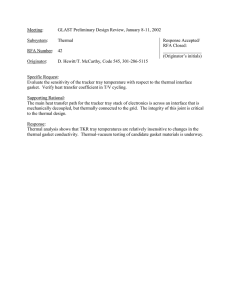An introduction to gasket selection and installation
advertisement

Column An introduction to gasket selection and installation By Alex Lattimer, ESA member G askets are often considered a commodity item which can mean that important considerations are often overlooked during selection. This article introduces some of the key issues relating to gasket technology and highlights the important factors to consider when selecting a gasket for a particular duty. The variety of different gasket types, material combinations and standards can make the choice bewildering and can result in selection based on what was previously installed rather than what is best for that particular application. By considering some relatively simple criteria and engaging your gasket supplier in the selection process, the most appropriate gasket can be selected. This will help to ensure you obtain the optimum performance from your bolted joint assembly and avoid unnecessary and costly environmental, safety and production issues. Before discussing the specific criteria relating to gasket design and selection it is important to refresh our knowledge about bolted joints. A gasket is a key component of a bolted joint however the flanges, bolts (including nuts and washers) and assembly method all contribute to the ability of the joint to seal. That is why we should describe any problem as being related to the bolted joint and not just the gasket or flange. Deciding on the best gasket for an application depends on several factors: • Performance – Temperature, pressure, media Gasket manufacturers invest heavily in product development • Application – Flange type, geometry, bolts • Standards - Environmental or regulatory requirements • People – Installation criteria, competency Performance: The operating conditions of the application will begin to define the selection of the correct gasket material and style. What is the temperature of the media – is operating temperature constant or is it likely to fluctuate during service such as a heat exchanger? Extremes of temperature, either cryogenic or very high temperature can dramatically alter the performance of gasket materials. Gasket manufacturers will be able to provide PT (pressure vs. temp) charts as a guide but it is important to note that when operating at the extreme of both pressure and temperature close attention to gasket selection is recommended. What is the operating pressure of the system; will severe pressure spikes be likely? Is a vacuum a possibility? For example, if a spiral wound gasket is used without an inner ring in vacuum service the spiral sealing element can be damaged which will affect seal integrity. The performance of certain gasket materials is subject to thickness dependency – as thickness increases sealing performance is reduced. The media and chemical compatibility of the components must be considered. Is the media a gas or liquid or a combination? Does it contain particulates? The chemical properties of the media such as pH and concentration must be taken into account. The gasket material must not react adversely with the fluid being sealed but similarly it must not contaminate the product stream. This is crucial in food and pharmaceutical applications. Also, does the gasket need special preparation or cleaning to avoid contamination; a requirement for some applications involving oxygen or chlorine? Gasket manufacturers have extensive chemical compatibility information; however it may be necessary to undertake lab tests to establish the suitability of a material for a particular service. Application: The wide range of gaskets means careful selection is crucial www.valve-world.net The flange design is very important in the determination of the correct gasket style and material. The majority of flanges January / February 2012 1 Column Understanding the application and service is important to select the best available gasket technology in industrial applications are metallic however there are many applications where low bolt loads are imposed when using plastic, GRP or glass lined flanges. These applications require gaskets that will seal at low surface stresses. At the other end of the scale, high pressure metallic flanges require resilient gasket materials that can cope with the high internal pressures as well as the high surface loads required to effect and maintain a seal. There are many different flange types and the geometry will dramatically affect the amount of surface stress on a gasket and whilst gaskets can be very forgiving, failing to meet the minimum seating stress or exceeding the maximum surface stress will affect performance. With certain flange geometries the compression of the gasket is controlled, however if this is not the case a compression limiting device such as the outer and inner rings of a spiral wound gasket or the solid metal core of a kammprofile is needed to prevent the gasket from being over compressed. The surface finish of the flange faces will impact on performance and is critical particularly when using metal to metal seals. The condition of the flange may have deteriorated over time so any scoring, pitting or damage to the flange face will affect performance as will corrosion, erosion, warping or rotation. All these factors will need to be considered. Standards: In many applications certain industry standards will apply such as ASME B16.20, API 6A or EN12560 that define criteria for materials, types of construction, dimensions etc that will help to define the gasket selection. There may be company or client piping specifications that dictate 2 January / February 2012 Accredited installation training is vital for a successful seal the specific grade of materials to use (e.g. graphite purity) or the type of gasket (e.g. spiral wound gasket with inner and outer rings). In certain markets gasket selection is driven by environmental issues, such as the German TA Luft regulations, in such cases only gaskets meeting certain strict emissions criteria may be considered. Gasket selection may be restricted by other mandatory requirements such as API 6FB compliance that imposes minimum sealing criteria in the event of a fire. People: Once all of the performance, application and standards requirements have been accommodated it is crucial to consider the installation requirements and the challenges that may result. The installation of a gasket in the controlled conditions of a well lit, clean, dry and warm factory may be a far cry from the reality on site. Access to the flange, lifting requirements and practical installation needs should be considered. A large diameter gasket can be easily damaged when lifted so if the joint is at height, consideration to how the gasket will be offered up to the flange is important. All of the above considerations can be in vain if the gasket is not properly installed. The incorrect installation of a gasket is one of the most common causes of joint failure. There are a number of key steps to follow to ensure the gasket is correctly installed and these are outlined in the following documents and standards– ESA Guidelines for safe seal usage, ASME PCC1-2010; EN1591-4 (draft) and Energy Institute Guidelines. The basic principles ensure that 1. The gasket is fit for purpose. 2. The flanges are clean and in an acceptable surface condition. 3. The studs (or bolts), nuts and washers are fit for purpose. 4. The installation procedure is controlled i.e. a defined bolt tightening sequence, correct lubrication, defined torque or tensioning levels and checking procedures. 5. Management and recording of joint information. Summary Gasket selection does not have to be difficult and by appropriate consideration to the key criteria of performance, application, standards and people, sealing performance can be optimised, minimising the probability of seal failure and associated costs. The European Sealing Association (ESA) has produced this article as a guide towards Best Available Techniques for sealing systems and devices. These articles are published on a regular basis, as part of their commitment to users, contractors and OEM’s, to help to find the best solutions for sealing challenges and to achieve maximum, safe performance during the lifetime of the seal. The ESA is the voice of the fluid sealing industry in Europe, collaborating closely with the Fluid Sealing Association (FSA) of the USA. Together, they form a key source of technical information on sealing technology, which is the basis for these articles. For more information, please visit www.europeansealing.com www.valve-world.net

